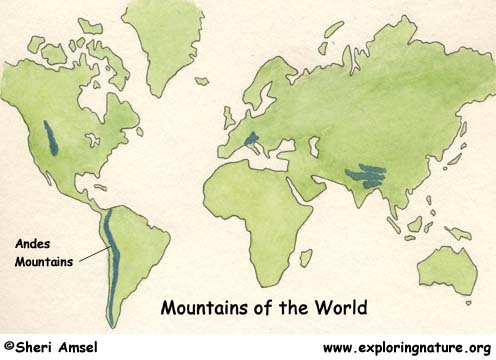

The Andes are the longest chain of mountains in the world. They stretch along the entire west coast of South America from Panama to Cape Horn on the southern tip of the continent. The highest peak is 22,000 feet and the many ranges or cordillas of mountains that make up the Andes from a barrier of continuous rock and snow for 5,000 miles.
The Andes were formed millions of years ago by folds and faults in the earth’s crust. Weird, jagged shapes were cut and left by ancient, shifting glaciers. Volcanoes have pushed up through many of the mountains. The Andes include deep gorges in green tropical mountains and high, jagged snowcapped peaks. Many of the high peaks are still covered by glacial ice. Because they vary in elevation, the vegetation found from place to place can differ greatly.
On high plateaus, vicunas run wild in small herds, grazing on the sparse grass. They are a high-altitude animal. They live at 12,000 feet. They are protected from the fierce cold by their thick, woolly fleeces. Another Andean animal famous for its beautiful hide is the chinchilla. Both the chinchilla and the vicuna have been heavily hunted by humans for their silken fur. The chinchillas were so over-hunted that now they survive only in the high Chilean Andes. Living in groups, they burrow in the rocky slopes, feeding at night and relaxing in the warm morning sun. The rhea, an ostrich-like bird, also shares the high plateaus, grazing and traveling in small groups. The Andean condor, biggest of all vultures, glides on a 10-foot wingspan searching for small prey or carrion. Bright red cock-in-the-rocks nest on high cliffs overlooking river gorges. Animals here have to adapt to strong winds that blow all the time in these rugged mountains.
The Andes has forests of polylepis, trees related to the rose. They are well adapted for the extreme temperatures of the mountains.
When you research information you must cite the reference. Citing for websites is different from citing from books, magazines and periodicals. The style of citing shown here is from the MLA Style Citations (Modern Language Association).
When citing a WEBSITE the general format is as follows.
Author Last Name, First Name(s). "Title: Subtitle of Part of Web Page, if appropriate." Title: Subtitle: Section of Page if appropriate. Sponsoring/Publishing Agency, If Given. Additional significant descriptive information. Date of Electronic Publication or other Date, such as Last Updated. Day Month Year of access < URL >.
Amsel, Sheri. "Andes of South America" Exploring Nature Educational Resource ©2005-2024. December 13, 2024
< http://exploringnature.org/db/view/Andes-of-South-America >

